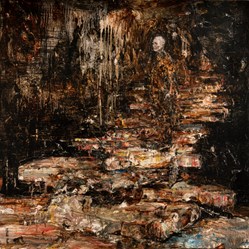13 Sep - 20 Oct, 2023

Statement:
Tube Culture Hall is thrilled to announce the opening of MADAME, MADAME, a duo show of Laura Berger and Azadeh Elmizadeh. Between defined, assimilated and naked bodies, and cloudy clusters of sulfurous images, this bi-personal exhibition titled “Madame, Madame” is heavily inspired by “The Second Sex,” an essay by French writer and philosopher Simone de Beauvoir, first published in Paris in 1949, and aims to contribute to the further disentanglement of that knotted skein that still haunts humanity today; and which concerns the subordinate status of women in all phases of life, from childhood to sexual baptism, from maturity to old age, no holds barred.///
Appealing granitically to that axiom that in a world where the two sexes were equal, both would be freer, de Beauvoir herself argues that it is essential that women are necessarily fully integrated into society with the same rights and duties as man, including civil, political, and legal recognition, and that consequent achievements should be accordingly recognized. In support of this thesis, to be considered as a primary source of inspiration for “Madame, Madame,” Italian activist and politician Adele Faccio, among early proponents of a woman’s right to self-determination on matters concerning her own body, stated with intelligible determination during one of her best-known television interviews that we “are not male and female cut with a knife.”
In light of such premises, through the tangible manifestation of the creative interpretation of reality, floating movements, amniotic dances, and a skillful emphasis on colors—all elements to be understood as genuine vital impulses—the two artists involved here, American Laura Berger (*1979), and Iranian by birth but Canadian by adoption, Azadeh Elmizadeh (*1987), have generously contributed, according to their own artistic beliefs, to writing the pages of this unprecedented exhibition chapter called “Madame, Madame.”
Laura Berger understands painting as a pure medium for exploring what it means to be human and to be alive and connected to each other—with our own unique experiences and stories, yet ready to share and put into practice that valuable notion of inclusive collectivity, never forgetting what has been though unaware of what lies ahead.
Berger first began painting as a therapeutic practice and this continues to be the foundation of her work: she uses color as a tool for centering and healing. It is a way of creating different and ever-more
surprising nuances of life; and she uses narrative and compositional exploration as a way to process various experiences and memories. She likes to leave the narrative and environmental elements so that they remain volatile and open within her phantasmagorical and bewitching paintings.
In this way she can create a feeling similar to that of a dream or a memory, somewhere between the mystical and mysterious, spontaneous and persuasive, sacred and profane, life and death. What most distinguishes her pictorial production is both the emotional and psychological energy that alkalizes each painting in order to create fluid stories that can include varied, unexpected, and amazing connections.
In addition, the figures that rivet her much-loved pictorial works could, moreover, represent the same character divided into itself—portraying various aspects of the self working together or arrayed against each other. Moreover, some figures, among those that often overlap, are marked by slight transparency and could metaphorically represent a spiritual self or even come from a past that nevertheless continues to be heard loudly.
Intentionally avoiding any kind of caesura, Azadeh Elmizade’s work examines how contingency, uncertainty, and analytical paraphrasing can be strategies used to undermine prescribed and now irrefutably anachronistic cultural boundaries. Elmizadeh’s entire practice is rooted in the slow process of layering of translucent oil painting glazes to visually build anticipation and temporal uncertainty, heading expeditiously toward the disruptive dynamics of becoming.
She makes paintings that continually give the impression of abstraction albeit slowly revealing subtle signs of representational gesture. In this new series of paintings, Elmizadeh explores the recurring motif frame which, in turn, takes on multiple forms such as doors, windows, and vignettes, simultaneously evoking modernist abstraction and attracting attention on implicit narrative content, from which results a harmonious mixture of heterogeneous elements that ultimately form one rich and homogeneous whole, elaborately supersensory and gently eurythmic.
Finally, in the words of the master of French realism Gustave Flaubert, in reference to his novel Madame Bovary: it may be true that “...no one, ever, can give the exact measure of one’s needs, nor of one’s concepts, nor of one’s pain, and the word human is like a cracked cauldron on which we come beating melodies designed to make the bears dance, when we like to soften the stars.”
Artists




